Cognitive Development: Piaget's Theory and Toy Project Analysis Essay
VerifiedAdded on 2024/06/28
|7
|1743
|320
Essay
AI Summary
This essay delves into Jean Piaget's theory of cognitive development, illustrating its stages through a personal toy project. It begins by introducing Piaget's background and his emphasis on children's active participation in learning. The essay then explores the four stages of cognitive development: sensorimotor, preoperational, concrete operational, and formal operational, providing personal experiences with toys at each stage to demonstrate how children's understanding and interaction with the world evolves. The author reflects on how their understanding of toys and games changed over time, aligning with Piaget's stages, from basic sensory exploration to abstract reasoning. The conclusion emphasizes the role of toys in a child's physical and mental development, highlighting that children are active learners who continuously experiment and adapt their knowledge.
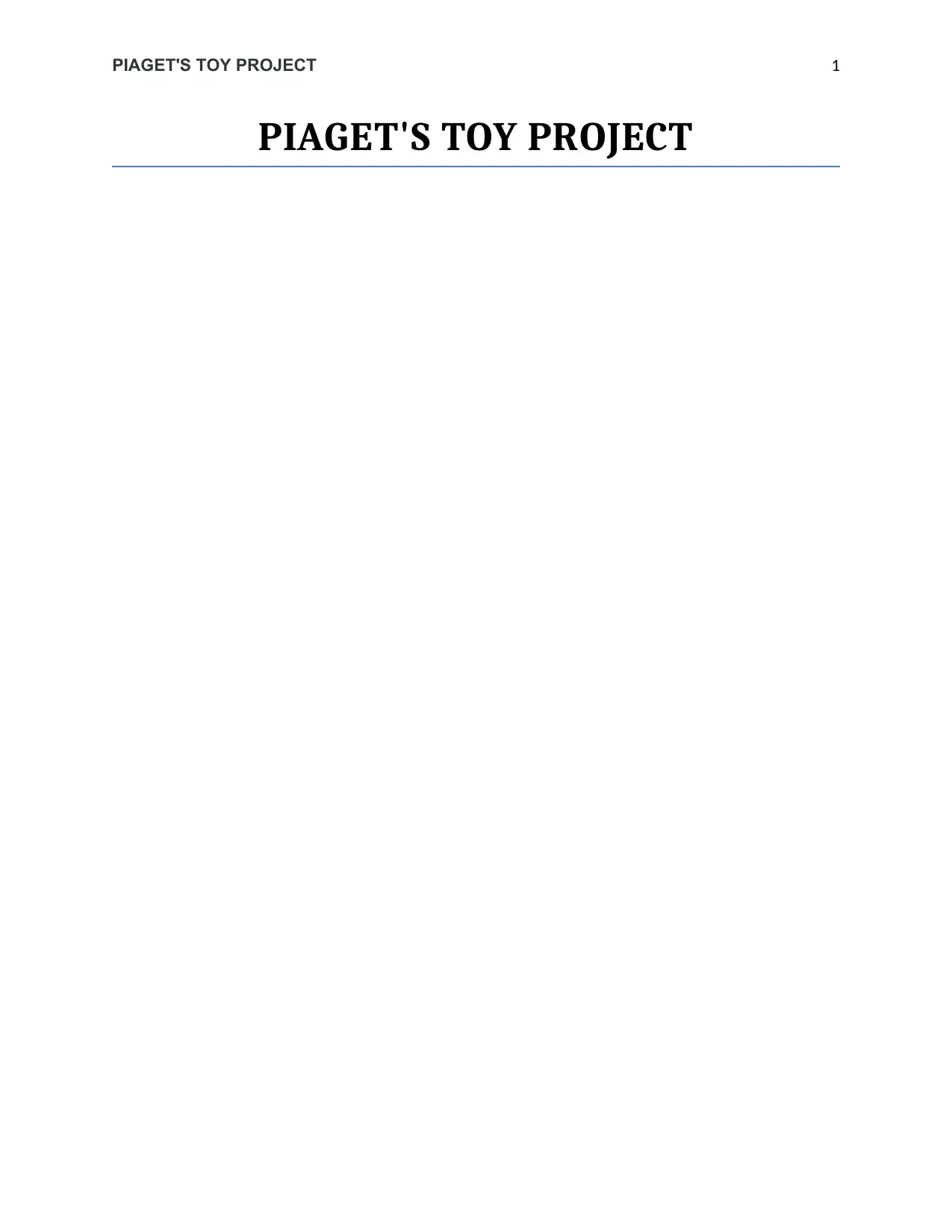
PIAGET'S TOY PROJECT 1
PIAGET'S TOY PROJECT
PIAGET'S TOY PROJECT
Paraphrase This Document
Need a fresh take? Get an instant paraphrase of this document with our AI Paraphraser
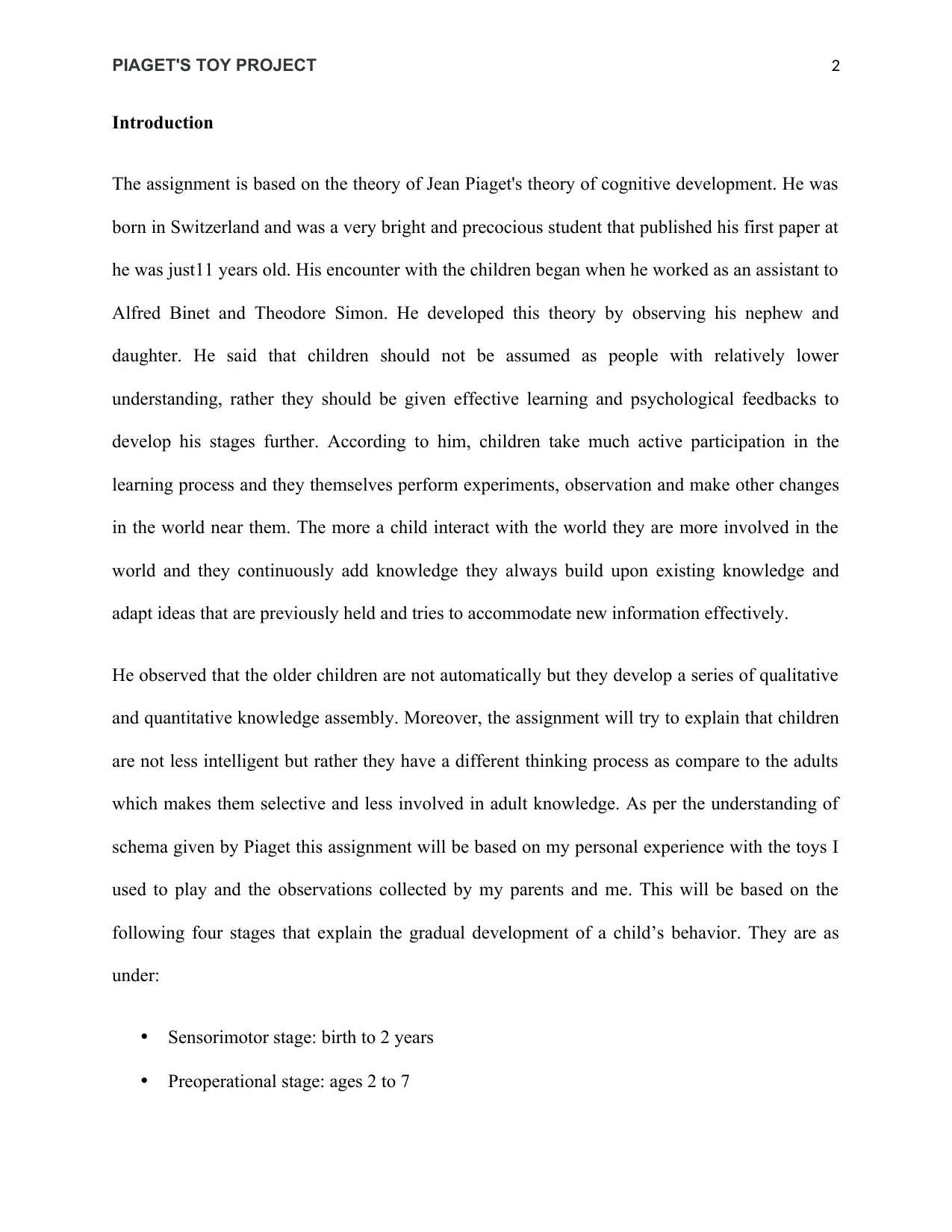
PIAGET'S TOY PROJECT 2
Introduction
The assignment is based on the theory of Jean Piaget's theory of cognitive development. He was
born in Switzerland and was a very bright and precocious student that published his first paper at
he was just11 years old. His encounter with the children began when he worked as an assistant to
Alfred Binet and Theodore Simon. He developed this theory by observing his nephew and
daughter. He said that children should not be assumed as people with relatively lower
understanding, rather they should be given effective learning and psychological feedbacks to
develop his stages further. According to him, children take much active participation in the
learning process and they themselves perform experiments, observation and make other changes
in the world near them. The more a child interact with the world they are more involved in the
world and they continuously add knowledge they always build upon existing knowledge and
adapt ideas that are previously held and tries to accommodate new information effectively.
He observed that the older children are not automatically but they develop a series of qualitative
and quantitative knowledge assembly. Moreover, the assignment will try to explain that children
are not less intelligent but rather they have a different thinking process as compare to the adults
which makes them selective and less involved in adult knowledge. As per the understanding of
schema given by Piaget this assignment will be based on my personal experience with the toys I
used to play and the observations collected by my parents and me. This will be based on the
following four stages that explain the gradual development of a child’s behavior. They are as
under:
Sensorimotor stage: birth to 2 years
Preoperational stage: ages 2 to 7
Introduction
The assignment is based on the theory of Jean Piaget's theory of cognitive development. He was
born in Switzerland and was a very bright and precocious student that published his first paper at
he was just11 years old. His encounter with the children began when he worked as an assistant to
Alfred Binet and Theodore Simon. He developed this theory by observing his nephew and
daughter. He said that children should not be assumed as people with relatively lower
understanding, rather they should be given effective learning and psychological feedbacks to
develop his stages further. According to him, children take much active participation in the
learning process and they themselves perform experiments, observation and make other changes
in the world near them. The more a child interact with the world they are more involved in the
world and they continuously add knowledge they always build upon existing knowledge and
adapt ideas that are previously held and tries to accommodate new information effectively.
He observed that the older children are not automatically but they develop a series of qualitative
and quantitative knowledge assembly. Moreover, the assignment will try to explain that children
are not less intelligent but rather they have a different thinking process as compare to the adults
which makes them selective and less involved in adult knowledge. As per the understanding of
schema given by Piaget this assignment will be based on my personal experience with the toys I
used to play and the observations collected by my parents and me. This will be based on the
following four stages that explain the gradual development of a child’s behavior. They are as
under:
Sensorimotor stage: birth to 2 years
Preoperational stage: ages 2 to 7
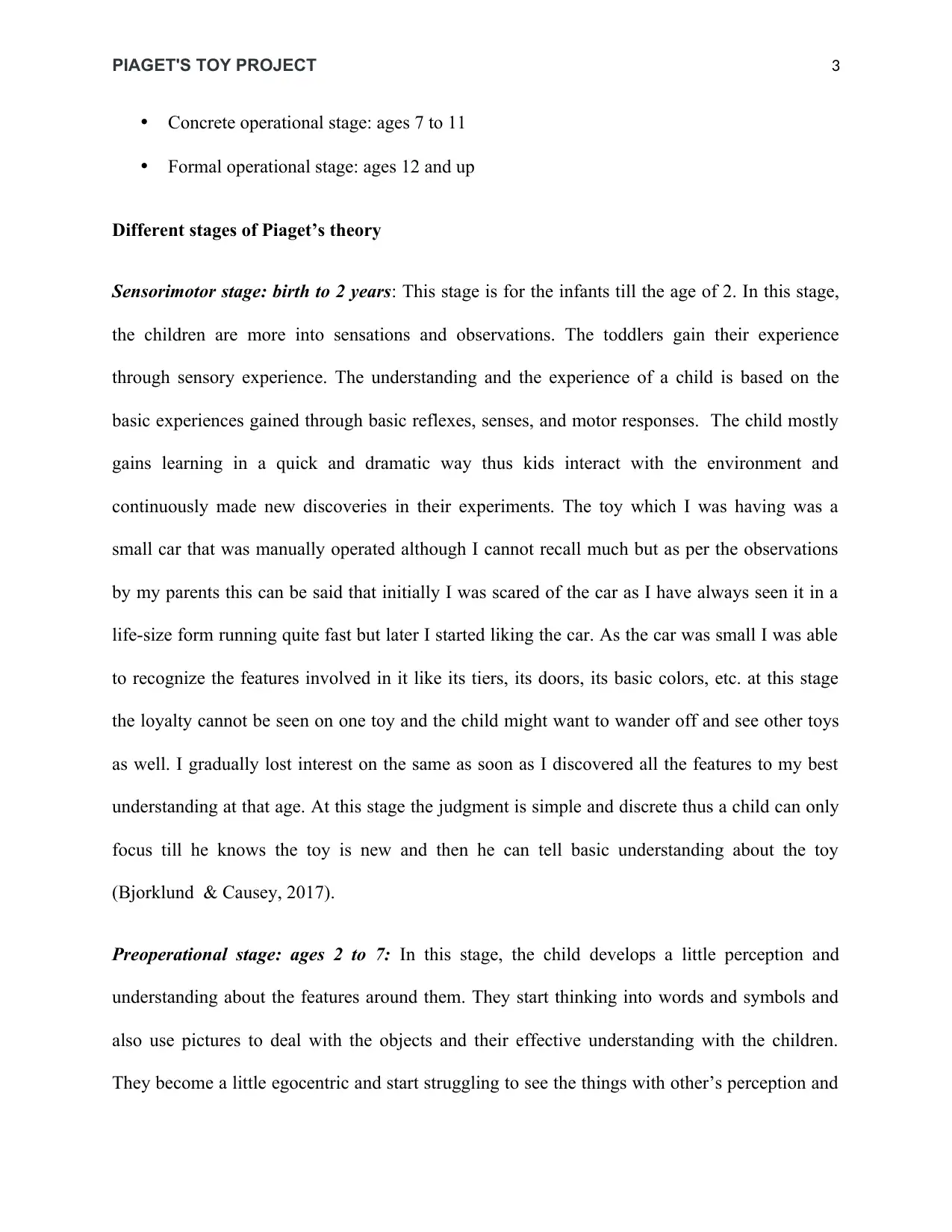
PIAGET'S TOY PROJECT 3
Concrete operational stage: ages 7 to 11
Formal operational stage: ages 12 and up
Different stages of Piaget’s theory
Sensorimotor stage: birth to 2 years: This stage is for the infants till the age of 2. In this stage,
the children are more into sensations and observations. The toddlers gain their experience
through sensory experience. The understanding and the experience of a child is based on the
basic experiences gained through basic reflexes, senses, and motor responses. The child mostly
gains learning in a quick and dramatic way thus kids interact with the environment and
continuously made new discoveries in their experiments. The toy which I was having was a
small car that was manually operated although I cannot recall much but as per the observations
by my parents this can be said that initially I was scared of the car as I have always seen it in a
life-size form running quite fast but later I started liking the car. As the car was small I was able
to recognize the features involved in it like its tiers, its doors, its basic colors, etc. at this stage
the loyalty cannot be seen on one toy and the child might want to wander off and see other toys
as well. I gradually lost interest on the same as soon as I discovered all the features to my best
understanding at that age. At this stage the judgment is simple and discrete thus a child can only
focus till he knows the toy is new and then he can tell basic understanding about the toy
(Bjorklund & Causey, 2017).
Preoperational stage: ages 2 to 7: In this stage, the child develops a little perception and
understanding about the features around them. They start thinking into words and symbols and
also use pictures to deal with the objects and their effective understanding with the children.
They become a little egocentric and start struggling to see the things with other’s perception and
Concrete operational stage: ages 7 to 11
Formal operational stage: ages 12 and up
Different stages of Piaget’s theory
Sensorimotor stage: birth to 2 years: This stage is for the infants till the age of 2. In this stage,
the children are more into sensations and observations. The toddlers gain their experience
through sensory experience. The understanding and the experience of a child is based on the
basic experiences gained through basic reflexes, senses, and motor responses. The child mostly
gains learning in a quick and dramatic way thus kids interact with the environment and
continuously made new discoveries in their experiments. The toy which I was having was a
small car that was manually operated although I cannot recall much but as per the observations
by my parents this can be said that initially I was scared of the car as I have always seen it in a
life-size form running quite fast but later I started liking the car. As the car was small I was able
to recognize the features involved in it like its tiers, its doors, its basic colors, etc. at this stage
the loyalty cannot be seen on one toy and the child might want to wander off and see other toys
as well. I gradually lost interest on the same as soon as I discovered all the features to my best
understanding at that age. At this stage the judgment is simple and discrete thus a child can only
focus till he knows the toy is new and then he can tell basic understanding about the toy
(Bjorklund & Causey, 2017).
Preoperational stage: ages 2 to 7: In this stage, the child develops a little perception and
understanding about the features around them. They start thinking into words and symbols and
also use pictures to deal with the objects and their effective understanding with the children.
They become a little egocentric and start struggling to see the things with other’s perception and
⊘ This is a preview!⊘
Do you want full access?
Subscribe today to unlock all pages.

Trusted by 1+ million students worldwide
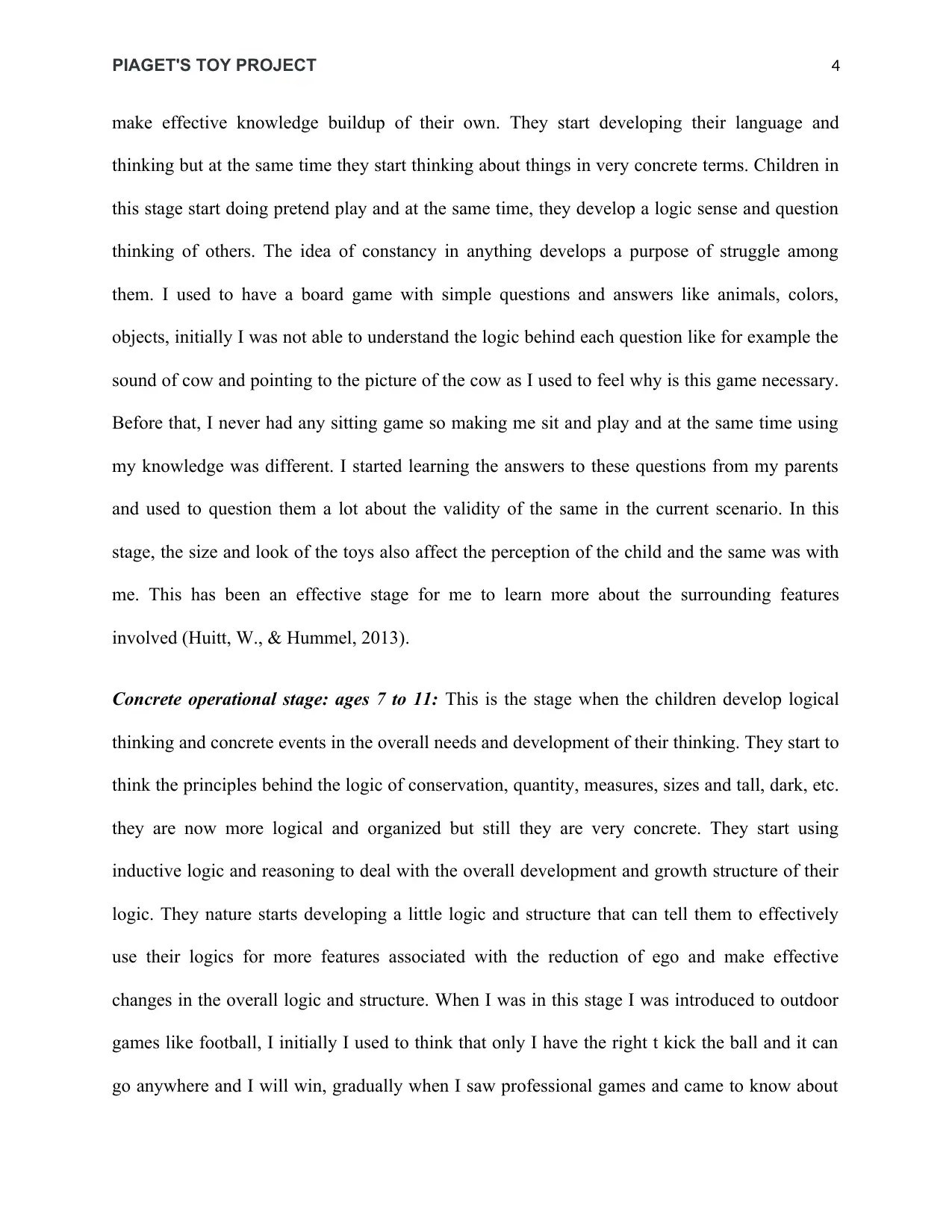
PIAGET'S TOY PROJECT 4
make effective knowledge buildup of their own. They start developing their language and
thinking but at the same time they start thinking about things in very concrete terms. Children in
this stage start doing pretend play and at the same time, they develop a logic sense and question
thinking of others. The idea of constancy in anything develops a purpose of struggle among
them. I used to have a board game with simple questions and answers like animals, colors,
objects, initially I was not able to understand the logic behind each question like for example the
sound of cow and pointing to the picture of the cow as I used to feel why is this game necessary.
Before that, I never had any sitting game so making me sit and play and at the same time using
my knowledge was different. I started learning the answers to these questions from my parents
and used to question them a lot about the validity of the same in the current scenario. In this
stage, the size and look of the toys also affect the perception of the child and the same was with
me. This has been an effective stage for me to learn more about the surrounding features
involved (Huitt, W., & Hummel, 2013).
Concrete operational stage: ages 7 to 11: This is the stage when the children develop logical
thinking and concrete events in the overall needs and development of their thinking. They start to
think the principles behind the logic of conservation, quantity, measures, sizes and tall, dark, etc.
they are now more logical and organized but still they are very concrete. They start using
inductive logic and reasoning to deal with the overall development and growth structure of their
logic. They nature starts developing a little logic and structure that can tell them to effectively
use their logics for more features associated with the reduction of ego and make effective
changes in the overall logic and structure. When I was in this stage I was introduced to outdoor
games like football, I initially I used to think that only I have the right t kick the ball and it can
go anywhere and I will win, gradually when I saw professional games and came to know about
make effective knowledge buildup of their own. They start developing their language and
thinking but at the same time they start thinking about things in very concrete terms. Children in
this stage start doing pretend play and at the same time, they develop a logic sense and question
thinking of others. The idea of constancy in anything develops a purpose of struggle among
them. I used to have a board game with simple questions and answers like animals, colors,
objects, initially I was not able to understand the logic behind each question like for example the
sound of cow and pointing to the picture of the cow as I used to feel why is this game necessary.
Before that, I never had any sitting game so making me sit and play and at the same time using
my knowledge was different. I started learning the answers to these questions from my parents
and used to question them a lot about the validity of the same in the current scenario. In this
stage, the size and look of the toys also affect the perception of the child and the same was with
me. This has been an effective stage for me to learn more about the surrounding features
involved (Huitt, W., & Hummel, 2013).
Concrete operational stage: ages 7 to 11: This is the stage when the children develop logical
thinking and concrete events in the overall needs and development of their thinking. They start to
think the principles behind the logic of conservation, quantity, measures, sizes and tall, dark, etc.
they are now more logical and organized but still they are very concrete. They start using
inductive logic and reasoning to deal with the overall development and growth structure of their
logic. They nature starts developing a little logic and structure that can tell them to effectively
use their logics for more features associated with the reduction of ego and make effective
changes in the overall logic and structure. When I was in this stage I was introduced to outdoor
games like football, I initially I used to think that only I have the right t kick the ball and it can
go anywhere and I will win, gradually when I saw professional games and came to know about
Paraphrase This Document
Need a fresh take? Get an instant paraphrase of this document with our AI Paraphraser
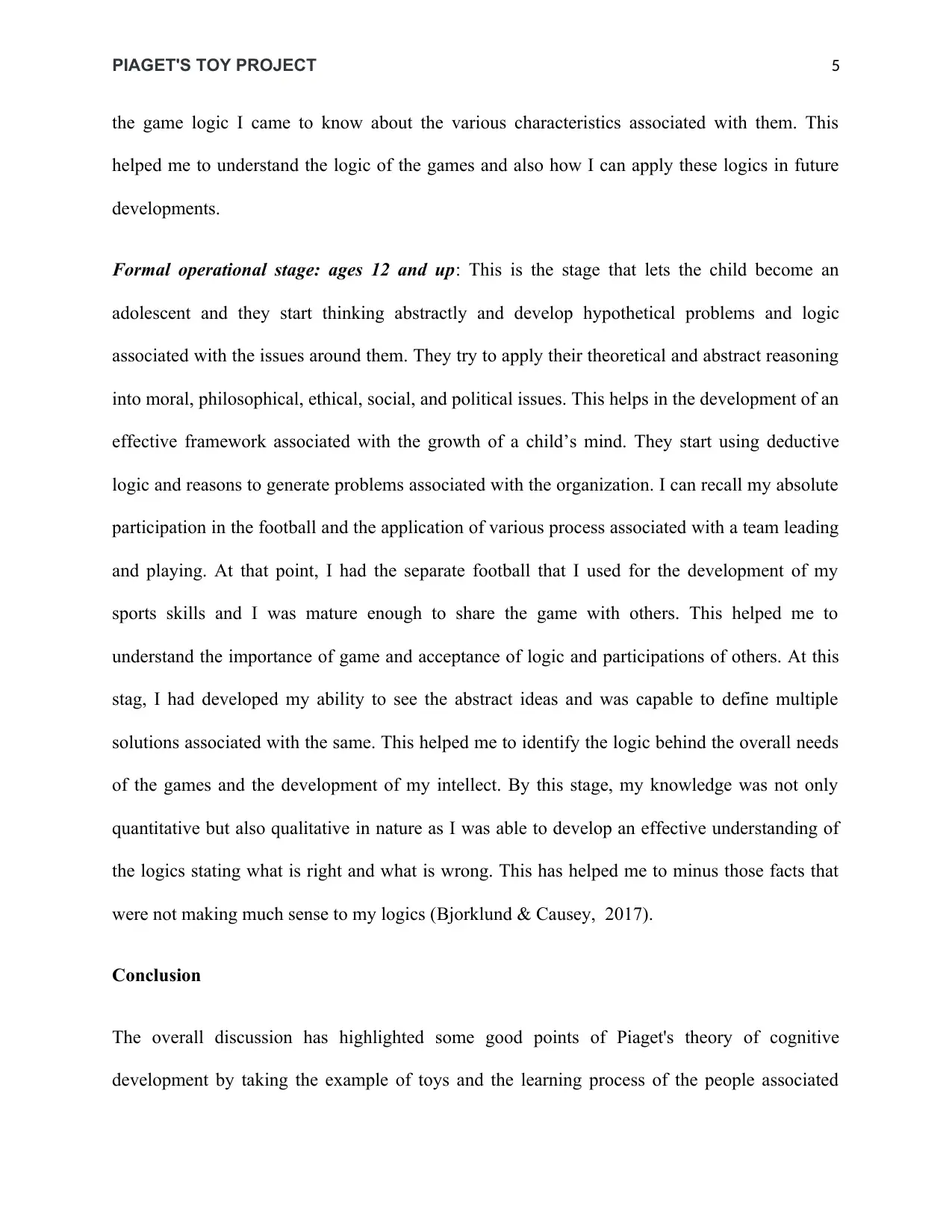
PIAGET'S TOY PROJECT 5
the game logic I came to know about the various characteristics associated with them. This
helped me to understand the logic of the games and also how I can apply these logics in future
developments.
Formal operational stage: ages 12 and up: This is the stage that lets the child become an
adolescent and they start thinking abstractly and develop hypothetical problems and logic
associated with the issues around them. They try to apply their theoretical and abstract reasoning
into moral, philosophical, ethical, social, and political issues. This helps in the development of an
effective framework associated with the growth of a child’s mind. They start using deductive
logic and reasons to generate problems associated with the organization. I can recall my absolute
participation in the football and the application of various process associated with a team leading
and playing. At that point, I had the separate football that I used for the development of my
sports skills and I was mature enough to share the game with others. This helped me to
understand the importance of game and acceptance of logic and participations of others. At this
stag, I had developed my ability to see the abstract ideas and was capable to define multiple
solutions associated with the same. This helped me to identify the logic behind the overall needs
of the games and the development of my intellect. By this stage, my knowledge was not only
quantitative but also qualitative in nature as I was able to develop an effective understanding of
the logics stating what is right and what is wrong. This has helped me to minus those facts that
were not making much sense to my logics (Bjorklund & Causey, 2017).
Conclusion
The overall discussion has highlighted some good points of Piaget's theory of cognitive
development by taking the example of toys and the learning process of the people associated
the game logic I came to know about the various characteristics associated with them. This
helped me to understand the logic of the games and also how I can apply these logics in future
developments.
Formal operational stage: ages 12 and up: This is the stage that lets the child become an
adolescent and they start thinking abstractly and develop hypothetical problems and logic
associated with the issues around them. They try to apply their theoretical and abstract reasoning
into moral, philosophical, ethical, social, and political issues. This helps in the development of an
effective framework associated with the growth of a child’s mind. They start using deductive
logic and reasons to generate problems associated with the organization. I can recall my absolute
participation in the football and the application of various process associated with a team leading
and playing. At that point, I had the separate football that I used for the development of my
sports skills and I was mature enough to share the game with others. This helped me to
understand the importance of game and acceptance of logic and participations of others. At this
stag, I had developed my ability to see the abstract ideas and was capable to define multiple
solutions associated with the same. This helped me to identify the logic behind the overall needs
of the games and the development of my intellect. By this stage, my knowledge was not only
quantitative but also qualitative in nature as I was able to develop an effective understanding of
the logics stating what is right and what is wrong. This has helped me to minus those facts that
were not making much sense to my logics (Bjorklund & Causey, 2017).
Conclusion
The overall discussion has highlighted some good points of Piaget's theory of cognitive
development by taking the example of toys and the learning process of the people associated
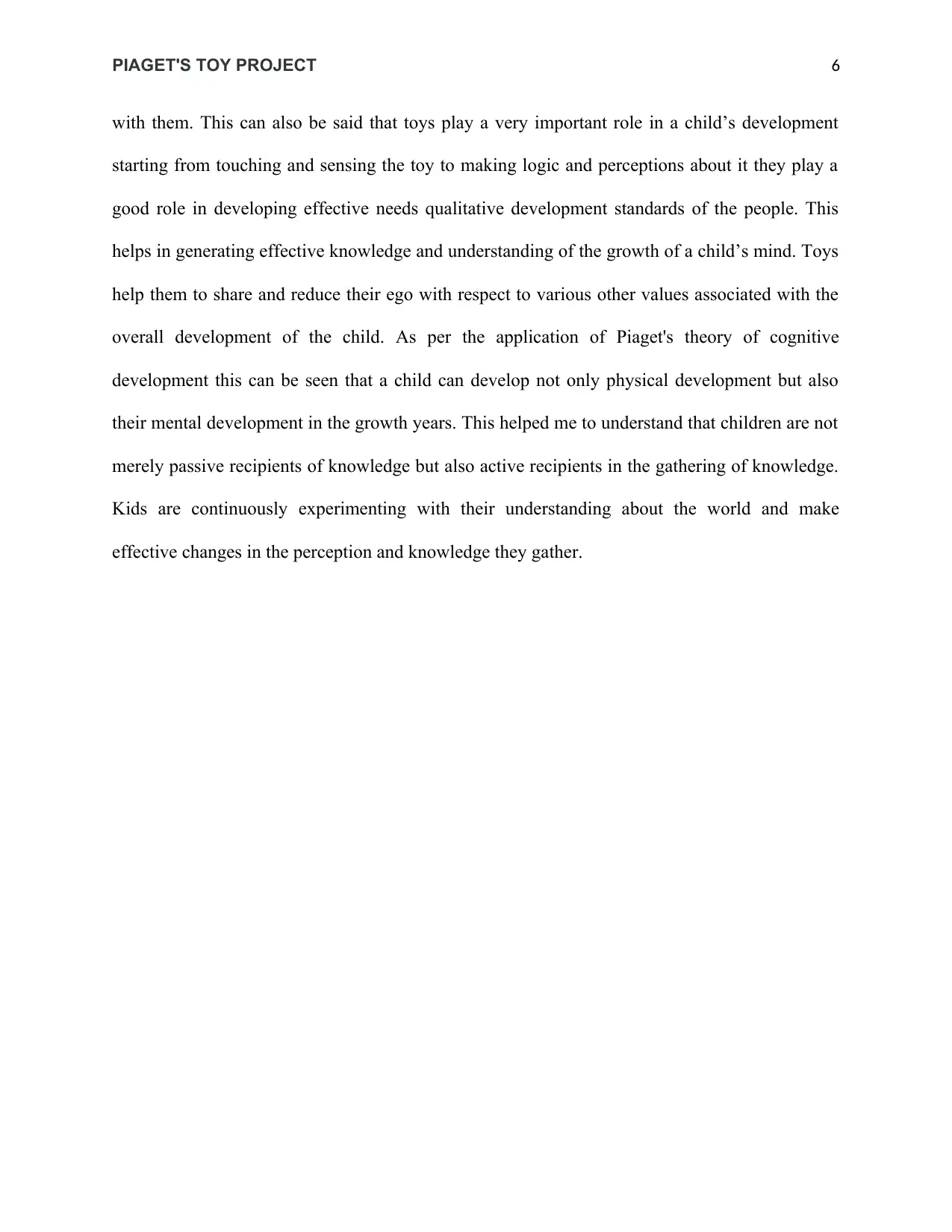
PIAGET'S TOY PROJECT 6
with them. This can also be said that toys play a very important role in a child’s development
starting from touching and sensing the toy to making logic and perceptions about it they play a
good role in developing effective needs qualitative development standards of the people. This
helps in generating effective knowledge and understanding of the growth of a child’s mind. Toys
help them to share and reduce their ego with respect to various other values associated with the
overall development of the child. As per the application of Piaget's theory of cognitive
development this can be seen that a child can develop not only physical development but also
their mental development in the growth years. This helped me to understand that children are not
merely passive recipients of knowledge but also active recipients in the gathering of knowledge.
Kids are continuously experimenting with their understanding about the world and make
effective changes in the perception and knowledge they gather.
with them. This can also be said that toys play a very important role in a child’s development
starting from touching and sensing the toy to making logic and perceptions about it they play a
good role in developing effective needs qualitative development standards of the people. This
helps in generating effective knowledge and understanding of the growth of a child’s mind. Toys
help them to share and reduce their ego with respect to various other values associated with the
overall development of the child. As per the application of Piaget's theory of cognitive
development this can be seen that a child can develop not only physical development but also
their mental development in the growth years. This helped me to understand that children are not
merely passive recipients of knowledge but also active recipients in the gathering of knowledge.
Kids are continuously experimenting with their understanding about the world and make
effective changes in the perception and knowledge they gather.
⊘ This is a preview!⊘
Do you want full access?
Subscribe today to unlock all pages.

Trusted by 1+ million students worldwide
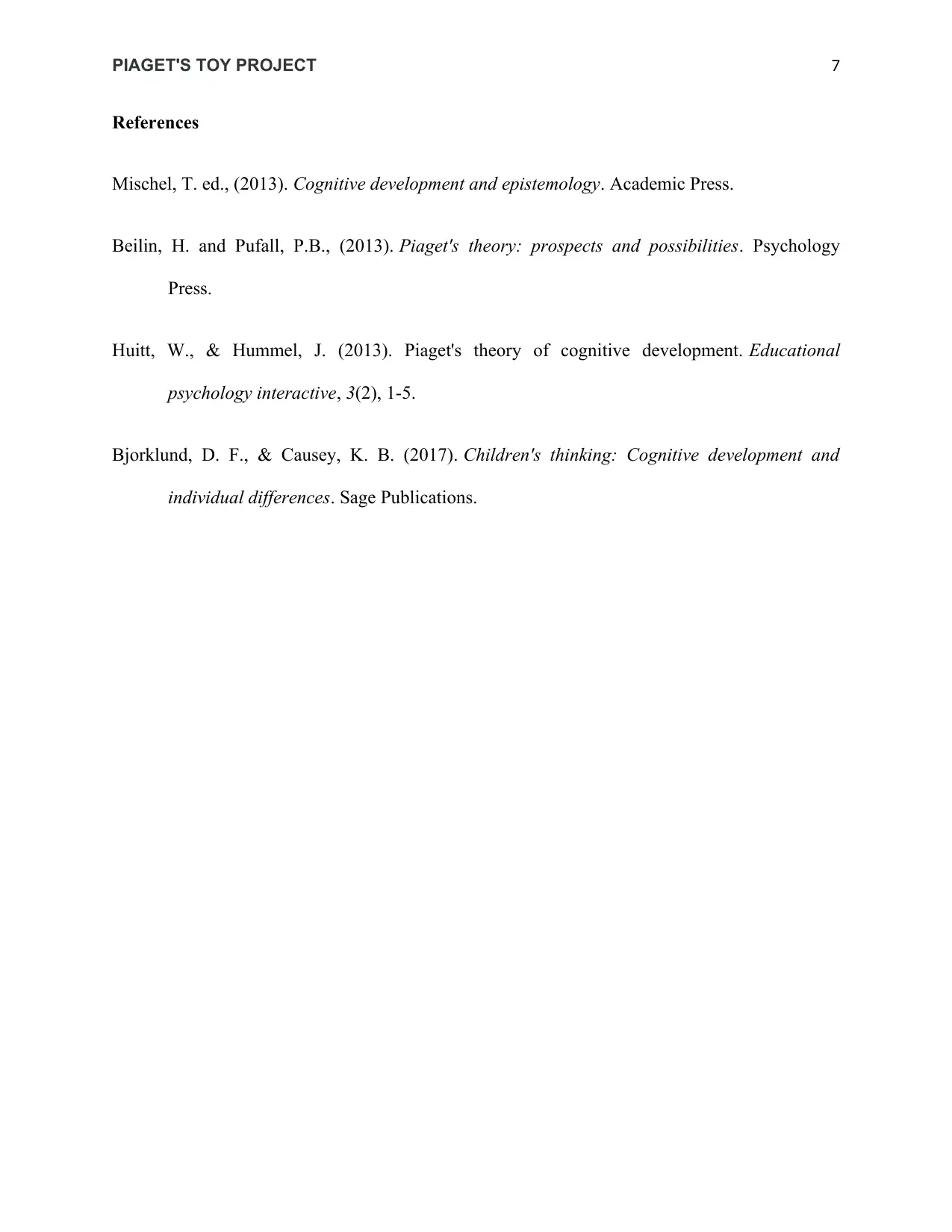
PIAGET'S TOY PROJECT 7
References
Mischel, T. ed., (2013). Cognitive development and epistemology. Academic Press.
Beilin, H. and Pufall, P.B., (2013). Piaget's theory: prospects and possibilities. Psychology
Press.
Huitt, W., & Hummel, J. (2013). Piaget's theory of cognitive development. Educational
psychology interactive, 3(2), 1-5.
Bjorklund, D. F., & Causey, K. B. (2017). Children's thinking: Cognitive development and
individual differences. Sage Publications.
References
Mischel, T. ed., (2013). Cognitive development and epistemology. Academic Press.
Beilin, H. and Pufall, P.B., (2013). Piaget's theory: prospects and possibilities. Psychology
Press.
Huitt, W., & Hummel, J. (2013). Piaget's theory of cognitive development. Educational
psychology interactive, 3(2), 1-5.
Bjorklund, D. F., & Causey, K. B. (2017). Children's thinking: Cognitive development and
individual differences. Sage Publications.
1 out of 7
Related Documents
Your All-in-One AI-Powered Toolkit for Academic Success.
+13062052269
info@desklib.com
Available 24*7 on WhatsApp / Email
![[object Object]](/_next/static/media/star-bottom.7253800d.svg)
Unlock your academic potential
Copyright © 2020–2025 A2Z Services. All Rights Reserved. Developed and managed by ZUCOL.





